Snapshot of Shinjuku
Shinjuku (Japanese): 新宿区, Shinjuku-ku, officially called Shinjuku City, is a special ward in the Tokyo Metropolis in Japan. Shinjuku is full of energy and pulsating power! It is a city that flourishes as the core of the Tokyo Metropolis. The present ward was established on March 15, 1947. It is a major commercial and administrative center which houses the northern half of the busiest railway station in the world (Shinjuku Station) and the Tokyo Metropolitan Government Building, the administration center for the government of Tokyo. As of 2018, the ward has an estimated population of 346,235. Shinjuku is now a major secondary center of Tokyo, rivaling the original city center in Marunouchi and Ginza.
Background Information
In 1634, during the Edo period, as the outer moat of the Edo Castle was built, a number of temples and shrines moved to the Yotsuya area on the western edge of Shinjuku. In 1698, Naitō-Shinjuku had developed as a new (shin) station, shuku or juku, on the Koshu Kaido, one of the major highways of that era. Naitō was the family name of a daimyo whose mansion stood in the area; his land is now a public park, the Shinjuku Gyoen. In 1898, the Yodobashi Water Purification Plant, the city’s first modern water treatment facility, was built in the area that is now between the park and the train station.
Modern Shinjuku
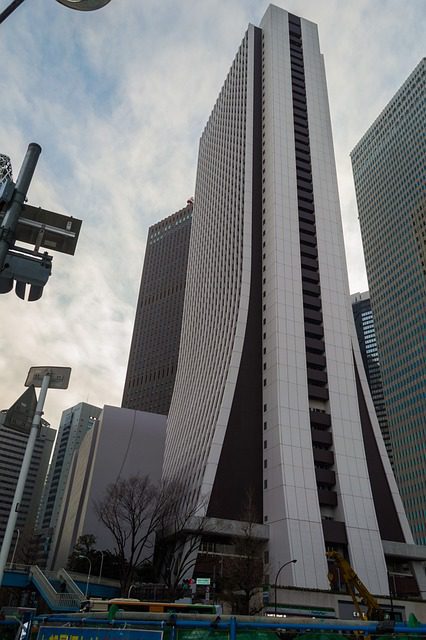
Modern Shinjuku
Shinjuku (新宿) is one of the 23 city wards of Tokyo, but the name commonly refers to just the large entertainment, business and shopping area around Shinjuku Station.
The current city of Shinjuku grew out of several separate towns and villages, which have retained some distinctions despite growing together as part of the Tokyo metropolis. Shinjuku is also commonly used to refer to the entire area surrounding Shinjuku Station. The west area is lined with skyscrapers; the east side is the most crowded one in Tokyo and south area is filled with new tourist spots. Shinjuku is a district of entertainment.
Shinjuku Station
Shinjuku Station is the world’s busiest railway station! handling more than two million passengers every day. About a dozen railway and subway lines serves Shinjuku Station, including the JR Yamanote Line. Shinjuku is also one of Tokyo’s major stops for long-distance highway buses. Therefore, a large bus terminal, named Busta Shinjuku is conveniently located on top of the railway station.
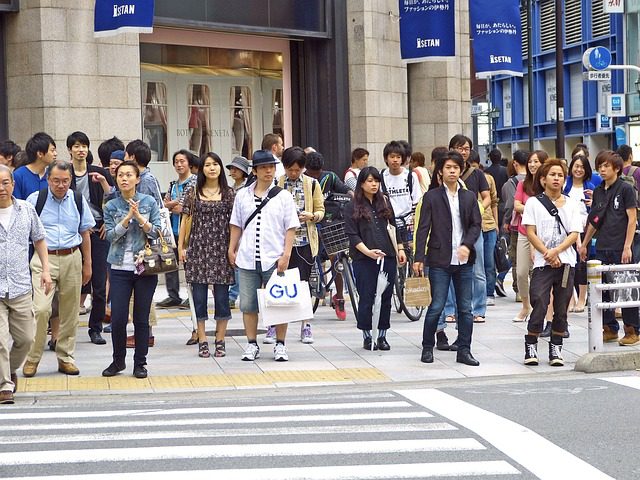
In and Around Shinjuku
West of the station is Shinjuku’s skyscraper district. It is home to many of Tokyo’s tallest buildings, including several premier hotels and the twin towers of the Metropolitan Government Office.
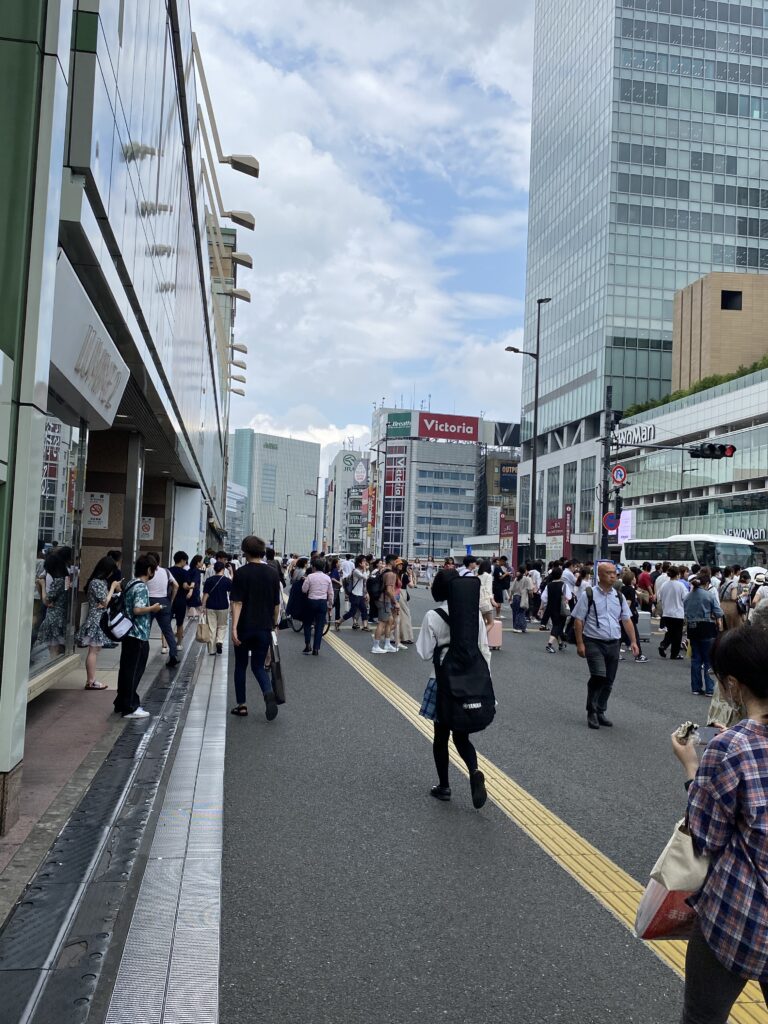
Northeast of the station lies Kabukicho, Japan’s largest red light district, while department stores, subterranean malls and electronic shops surround Shinjuku Station, including the redeveloped Southern Terrace.
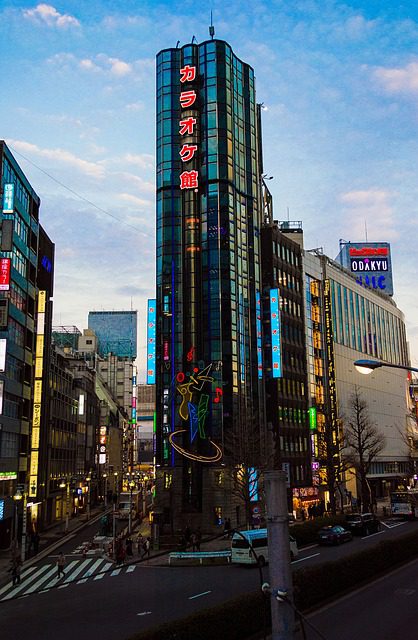
Getting to Shinjuku
Shinjuku Station is Japan’s busiest railway station, served by about a dozen railway lines, including the JR Yamanote Line.
From Tokyo Station
The orange trains on the JR Chuo Line take less than 15 minutes from Tokyo Station to Shinjuku Station.
From Ueno Station
By JR Yamanote Line, it takes 25 minutes to get from Ueno to Shinjuku. A slightly faster alternative is to take the JR Yamanote or JR Keihin-Tohoku Line from Ueno to Kanda Station, and then the JR Chuo Line from Kanda to Shinjuku.
Shinjuku Station is a major urban transit hub which sees an estimated 3.64 million passengers passing through each day. It is said to be the busiest station in the world. It houses interchanges to three subway lines and three privately owned commuter lines, as well as several JR lines.
Notable people from Shinjuku-ku
- Shinzo Abe, Past Prime Minister of Japan
PLACES TO SEE & THINGS TO DO
Cultural Centers
Museums & Halls
- National Printing Bureau Banknote and Postage Stamp Museum
- National Museum of Nature and Science, Shinjuku Branch
- Shinjuku Historical Museum
- Tokyo Fire Department Museum
- Tokyo Toy Museum
- Tokyo Opera City
- Shinjuku Bunka Center
- Meiji Yasuda Life Hall
Nishi Shinjuku Skyscrapers
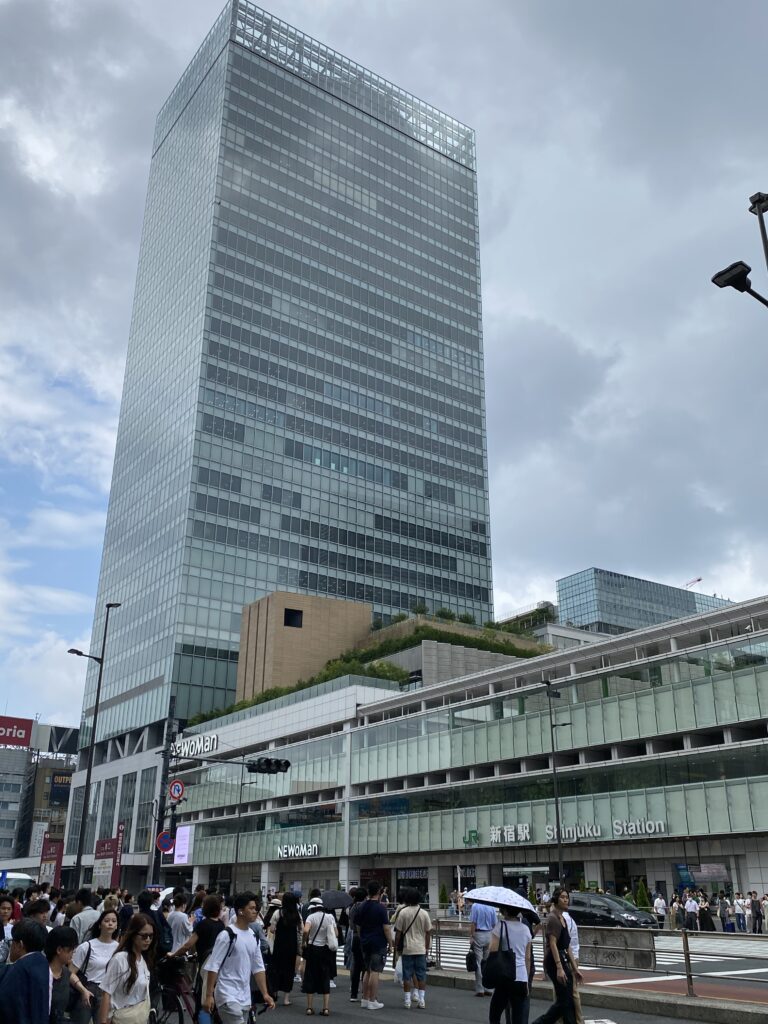
Nishi Shinjuku Skyscrapers – The area west of Shinjuku Station is home to a large number of skyscrapers including the Tokyo Metropolitan Government Building and hotels such as the Keio Plaza, Hilton, Park Hyatt and the Hyatt Regency which was featured in the movie, Lost in Translation. Many of the buildings have stores and restaurants with great views from the top floors.
Shinjuku Gyo-en National Garden
Shinjuku Gyo-en (新宿御苑) is one of Tokyo’s largest and most pleasant park and garden in Shinjuku and Shibuya, Tokyo, Japan. It was originally a residence of the Naitō family in the Edo period. Afterward, it became a garden under the management of Japan’s Imperial Household Agency. It was then opened to the public in 1949 after serving as a garden for the Imperial Family since 1903. It is now a national park under the jurisdiction of the Ministry of Environment. This park is one of the best cherry blossom viewing spots.
Tokyo Metropolitan Government Building
The Tokyo Metropolitan Government Building (Tōkyō Tochō) in Shinjuku is one of Tokyo’s landmarks. It has free observation decks on the 45th floor. This provides good panoramic views of Tokyo and beyond. The 243 metre tall building has two towers, and each houses an observatory at a height of 202 metres.
If weather conditions are good, visitors can see famous landmarks such as Mount Fuji, the Tokyo Skytree, Tokyo Tower, Meiji Shrine and the Tokyo Dome.
The Tokyo Tourist Information Centre is on the first floor of the Main Building. It offers tours by volunteers in English, Chinese and Korean.

Tokyo Metropolitan Government Office
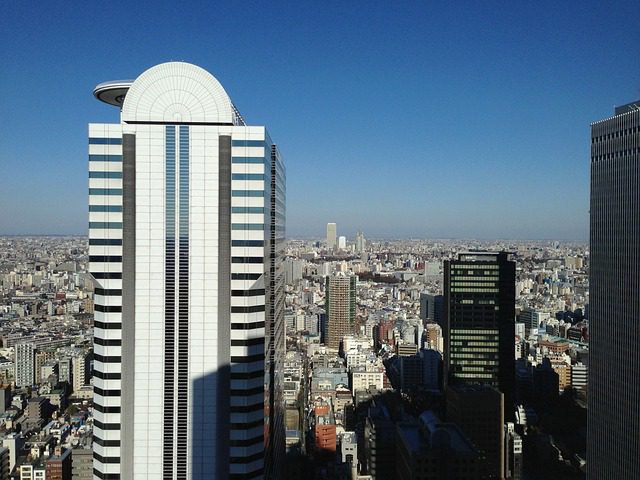
Hours: 9:30 to 22:00 (entry until 21:30)
Closed: Dec 29 to Jan 3 (except Jan 1) and occasional inspection days
Admission: Free
The 243 meter tall twin towers and surrounding buildings contain the offices and the assembly hall of the metropolitan government of Tokyo.
Omoide Yokocho
Omoide Yokocho, also affectionately known as Yakitori Lane or Memory Lane. This is a small network of alleyways along the tracks northwest of Shinjuku Station. The cramped alleyways of yakitori restaurants and bars brings visitors into a view of postwar Japan.
The location makes it a little tricky to locate. However, once there, it makes you temporarily forget that you are in Shinjuku, one of the busiest areas for business, entertainment, and shopping in Tokyo. Dozens of tiny eateries serving ramen, soba, sushi, yakitori and kushiyaki fill the narrow lanes.
Many restaurants consist of just one counter with some chairs, while others have a couple of tables. Many of the yakitori stalls are very small, just able to fit the kitchen counter and about 8 seats. The chef stands behind the kitchen counter grilling while customers sit along the counter. Customers are not bothered by the smoke of the grills, but just enjoy the sights, sounds and the atmosphere.
Kabukicho District
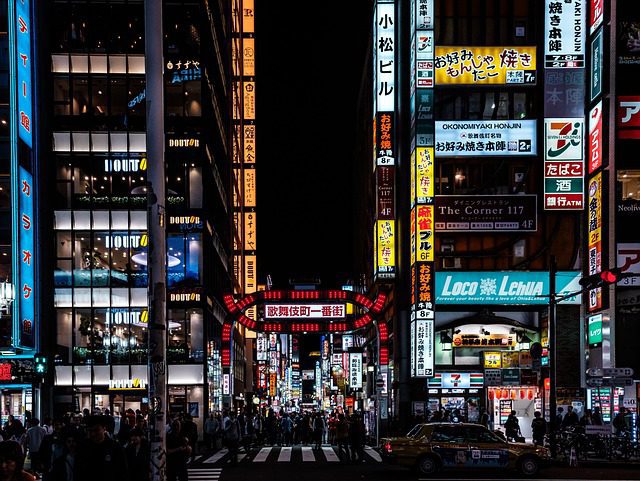
Kabukichō ( 歌舞伎町, Kabuki-chō,) is the major entertainment town in Shinjuku, Tokyo, Japan. Kabuki-chō is the location of many host & hostess clubs, love hotels shops, restaurants, nightclubs and game arcades. It is often called the “Sleepless Town” (眠らない街, Nemuranai Machi).
The district’s name comes from late-1940s plans to build a kabuki theater. Although the theater was never built, the name stuck.
Neon lights, countless restaurants and entertainment options fill this area. The robot restaurant is located within the same vicinity too. You can feel the energy of the place. At 11pm, it’s still a lively, bustling hub compared to Shinjuku where most of the shops are already closed.
Japan’s largest red light district features countless restaurants, bars, nightclubs, pachinko parlors, love hotels and a wide variety of red light establishments. Explore with caution and beware of exorbitant cover fees and drink spiking resulting in loss of cash and credit cards. Foreign tourists are typically targeted.
Shin-Okubo Koreatown
Shin-Okubo Koreatown is a collection of Korean shops and restaurants found along the main road and side streets around Shin-Okubo Station. It is one stop north of Shinjuku Station. Korean residents operate many of the shops and restaurants. They also sell a variety of Korean goods, including K-Pop music, videos and groceries.
Shop and restaurant hours vary
Hanazono-Jinja Shrine
This shrine dates back to the mid 17th century and is tucked away among the skyscrapers in Shinjuku. It is famous for its annual Tori-no-Ichi market in November where thousands of people flock to it to buy kazani-kumade (decorative rakes) food and other items. The Kumade are believed to help in “raking in” wealth and good fortune.
Meiji Jingu Gaien
Shrine’s history: The elegant Shinto shrine, built to honor the accomplishments of the Emperor Meiji and Empress Shoken, is dedicated to the divine souls of Emperor Meiji and Empress Shoken. 100,000 trees, donated from all around the world, (300 metres long) were planted to create this forest “for their souls to dwell in”. It does feels like a forest! There are a number of sake and wine barrels stacked for the royal spirits as well.
Annual events: On New Years’ Eve, it’s a Japanese tradition to pray for good luck in the new year, and Meiji Shrine is the most popular shrine for devotees. Over 3 million visitors wait for hours to make their first prayers of the year. The Shrine also has its own festivals, the Haru no Taisai, Spring Grand Festival on May 2, and the Aki no Taisai, Autumn Grand Festival, typically held in the very first days of November. This shrine is well worth a visit!.
Jingu Baseball Stadium
Baseball is one of Japan’s favorite sports, so they build an magnificent stadium. Jingu Stadium is the second oldest baseball ground in Japan after Koshien Stadium in Hyogo prefecture. It can accommodate approximately 37.933 spectators. It’s one of only four remaining stadiums in the world where, in 1934, the legendary Babe Ruth played. In addition, the landmark facility hosted the baseball games during the 1964 Tokyo Olympics. However, the stadium is slated to be demolished and replaced with new buildings. So now would be a good time to visit the stadium.
Shinjuku Expressway Bus Terminal
This bus terminal is the largest expressway bus terminal in Japan and it connects Shinjuku to the rest of Japan. It is the perfect place for shopping and gathering information. On the 3rd floor there is the Tokyo Tourist Information Centre. On the 4th floor, you will find the information centre, with service in English and Chinese. As well, you will find the ticket sales counter, coin lockers, a convenience store, and a souvenir shop.
Isetan Shinjuku Store
Built in 1933, the building is elegant and represents the items in the store. East of Shinjuku Station, this department store is one of the trendiest in Japan. It houses the finest in clothing, accessories, and homeware. It is also known for its impressive variety of foods.
With a history of over 100 years, Isetan is an expert among Shinjuku’s department stores. The Shinjuku store consists of ten floors, including restaurants on the top floors and a food department in the basement.
Tanji Kosuge opened the store as a kimono fabric shop in Tokyo’s Kanda district in 1886. It is now part of the international Isetan Mitsukoshi Holdings group. Although the store was remodeled in 2013 to give it a more modern look, the old charm is still there.
Godzilla head in Tokyo
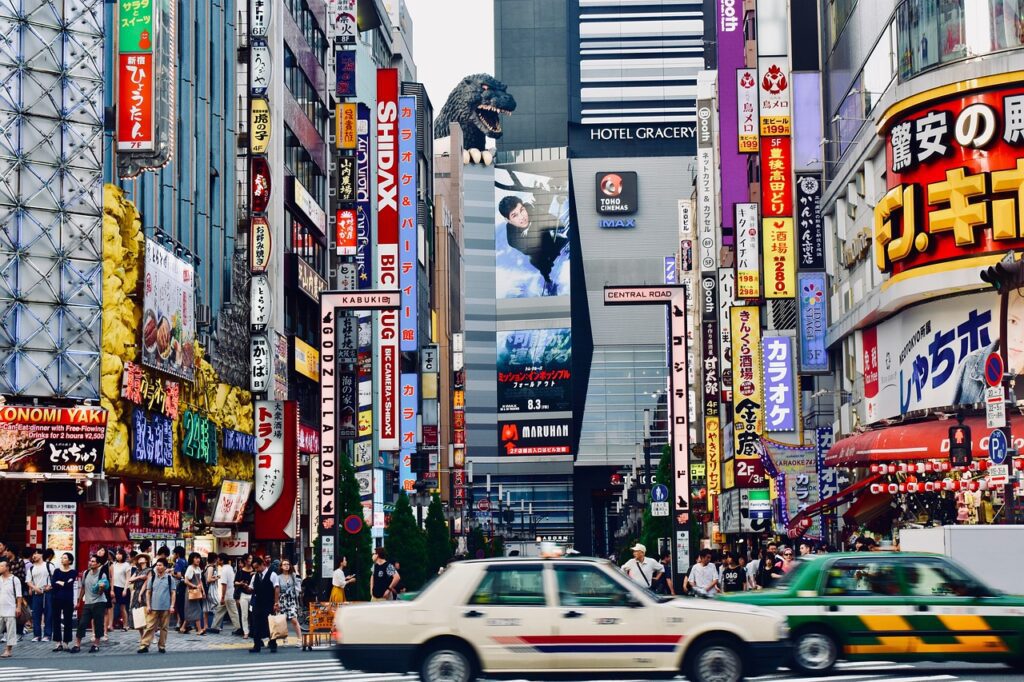
80-Ton Godzilla Head
This is one of the reasons I love Tokyo!
You can expect the unexpected and surreal. Walking down the street to see a Godzilla head poking over the building is fantastic.
The Godzilla Head (ゴジラヘッド Gojira Heddo) is a giant statue of the head of Godzilla. The Godzilla head is a landmark and tourist attraction in Kabukichō, Shinjuku, Tokyo, Japan. The sculpture is accessible from Hotel Gracery Shinjuku’s Godzilla Terrace, on the Shinjuku Toho Building.
It depicts Godzilla, occasionally with “glowing eyes and smoky breath“. The 80-ton head, based on Godzilla’s appearance in Godzilla vs. Mothra (1992), was unveiled in 2015. This Godzilla, towering over the Toho Cinema in Shinjuku, is probably the most famous in Tokyo.
Godzilla show – Godzilla and Gracery hotel do a mini show on the hour every hour. The show includes some visual effects, fire breath and a roar from Godzilla.
Takashimaya Department Store
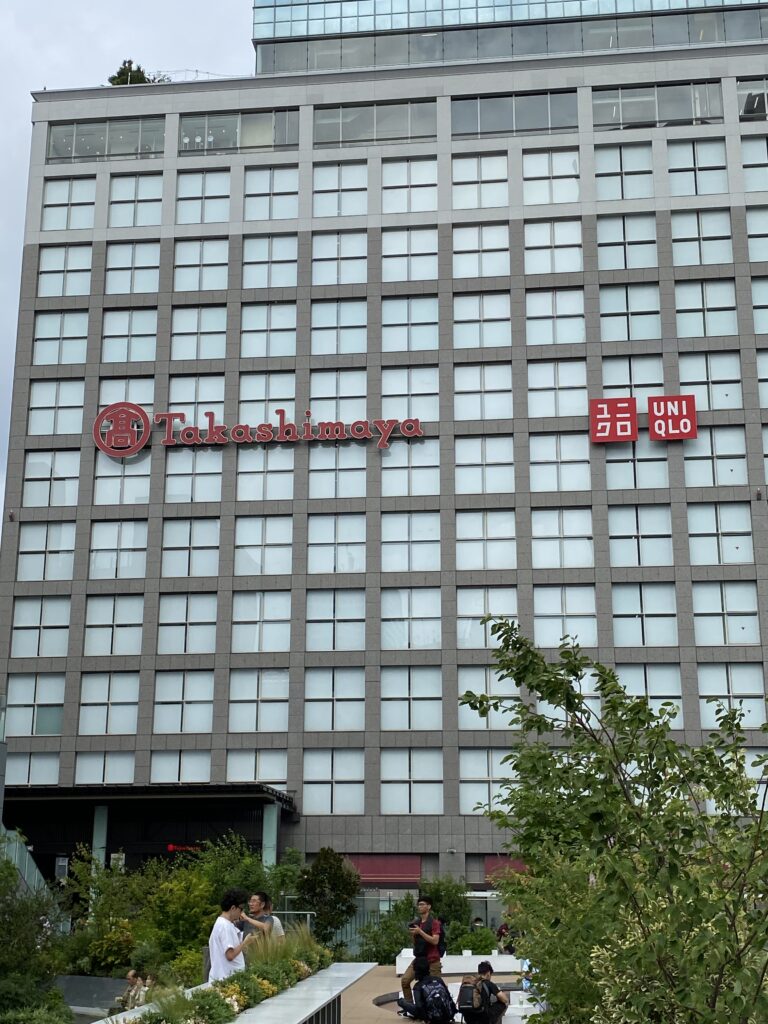
Takashimaya Department Store
Hours: 10:30 to 19:30
Restaurants: 11:00 to 23:00
Takashimaya department store is a must visit in Shinjuku!
The Shinjuku branch of Takashimaya was opened in 1996. It consists of 15 floors, including a food department in the basement and three restaurant floors. The store is attached to Shinjuku Station, Takashimaya Times Square complex, that houses a Kinokuniya book store. The bookstore has a large foreign language section.
There are 11 floors of goods to choose from, a basement food hall and a duty free section. The top three floors also feature a number of restaurants with delectable food on the menu.
Keio Department Store
Hours: 10:00 to 20:00
Restaurants: 11:00 to 22:00
Keio Department Store consists of 11 floors. This includes a food department in the basement and several restaurants on the restaurant floor. The department store belongs to the Keio Group, which also operates a suburban railway line from Shinjuku to Western Tokyo.
Lumine
Hours: 11:00 to 21:00
Restaurants: 11:00 to 22:00
Lumine is owned by JR East and located both next to and above Shinjuku Station’s South and East exits. Lumine is divided into “Lumine 1” and “Lumine 2” on either side of the South Exit. “Lumine Est” (formerly known as “My City”) above the East Exit.
Lumine 1 is the smallest of the three groups. It can be accessed via escalators to the west of the Odakyu Line gate and JR Shinjuku Station’s South Exit. There are also several entrances from the street and the Toei Shinjuku and Keio subway stations at Shinjuku.
Shinjuku Mylord
Hours: 11:00 to 21:00 (Mosaic Dori from 10:00)
Restaurants: 11:00 to 23:00
Mylord offers seven floors of shopping and three restaurant floors. Mylord is affiliated with the Odakyu Group. The complex also includes “Mosaic Dori“, a narrow pedestrian street behind the Keio department store. This connects the Shinjuku West and South Exits. Shinjuku Mylord offers a wide variety of trendy women’s items and accessories. Along Mosaic Street, are shops selling household items and other unique goods.
Electronic Stores
Yodobashi Camera
Hours: 9:30 to 22:00
Yodobashi Camera is one of Japan’s leading discount electronics retailers, its strong focus on camera equipment. Yodobashi’s main store is located near the west exit of Shinjuku Station. A smaller branch is located near the station’s east exit.
Bic Camera
Hours: 10:00 to 21:00
Bic Camera is another of Japan’s leading discount electronics retailers. It has two large stores in Shinjuku. There is one in the Odakyu Halc Building near the station’s west exit. There is another one east of the station near the Isetan department store.
Nooria
I open the website and I rad the information
That available it is interesting and attractive for
Reader with interesting combinations of the pictures for readers specially for who want to have travel here
Is specific information and knowledge before travelling . It is wonderful and interesting for me.
lmontague
Thank you Nooria for the feedback! I’m glad you found the information useful and interesting.